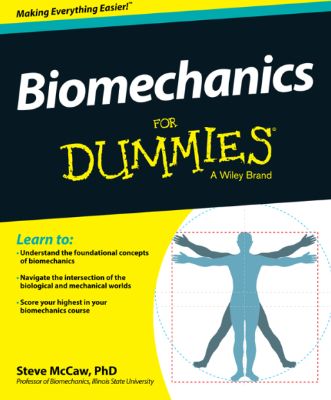
Lýsing:
A thorough explanation of the tenets of biomechanics At once a basic and applied science, biomechanics focuses on the mechanical cause-effect relationships that determine the motions of living organisms. Biomechanics for Dummies examines the relationship between biological and mechanical worlds. It clarifies a vital topic for students of biomechanics who work in a variety of fields, including biological sciences, exercise and sports science, health sciences, ergonomics and human factors, and engineering and applied science.
Following the path of a traditional introductory course, Biomechanics for Dummies covers the terminology and fundamentals of biomechanics, bone, joint, and muscle composition and function, motion analysis and control, kinematics and kinetics, fluid mechanics, stress and strain, applications of biomechanics, and black and white medical illustrations. Offers insights and expertise in biomechanics to provide an easy-to-follow, jargon-free guide to the subject Provides students who major in kinesiology, neuroscience, biomedical engineering, mechanical engineering, occupational therapy, physical therapy, physical education, nutritional science, and many other subjects with a basic knowledge of biomechanics Students and self-motivated learners interested in biological, applied, exercise, sports, and health sciences should not be without this accessible guide to the fundamentals.
Annað
- Höfundur: Steve McCaw
- Útgáfa:1
- Útgáfudagur: 2014-02-21
- Blaðsíður: 408
- Engar takmarkanir á útprentun
- Engar takmarkanir afritun
- Format:ePub
- ISBN 13: 9781118674765
- Print ISBN: 9781118674697
- ISBN 10: 1118674766
Efnisyfirlit
- Introduction
- About This Book
- Foolish Assumptions
- Icons Used in This Book
- Beyond the Book
- Where to Go from Here
- Part I: Getting Started with Biomechanics
- Chapter 1: Jumping Into Biomechanics
- Analyzing Movement with Biomechanics
- Mechanics
- Bio
- Expanding on Mechanics
- Describing motion with kinematics
- Causing motion with kinetics
- Putting Biomechanics to Work
- Analyzing Movement with Biomechanics
- Chapter 2: Reviewing the Math You Need for Biomechanics
- Getting Orientated
- Brushing Up on Algebra
- Following the order of operations
- Defining some math operations
- Isolating a variable
- Interpreting proportionality
- Looking for the Hypotenuse
- Using the Pythagorean theorem
- De-tricking trigonometric functions: SOH CAH TOA
- Unvexing Vector Quantities
- Resolving a vector into components
- Composing a vector from components
- Chapter 1: Jumping Into Biomechanics
- Chapter 3: Speaking the Language of Biomechanics
- Measuring Scalars and Vectors
- Standardizing a Reference Frame
- Directing your attention to locations of the body
- Referencing planes and axes
- Describing Movement: Kinematics
- Typecasting motion: Linear, angular, and general
- Describing how far: Distance and displacement
- Describing how fast: Speed and velocity
- Changing velocity: Acceleration
- Pushing and Pulling into Kinetics
- Forcing yourself to understand Newton's laws of motion
- Using the impulse–momentum relationship
- Working with Energy and Power
- Mechanical work
- Mechanical energy
- Mechanical power
- Turning Force into Torque
- Dealing with Measurement Units
- Using the Neuromusculoskeletal System to Move
- The skeletal system
- The muscular system
- The nervous system
- Chapter 4: Making Motion Change: Force
- Pushing and Pulling: What Is Force?
- Working with Force Vectors
- Using the force components to find the resultant
- Resolving a force into components
- Classifying Forces
- Contact and noncontact forces
- Internal and external forces
- Feeling the Pull of Gravity
- Slipping, Sliding, and Staying Put: Friction Is FµN
- Materials do matter: The coefficient of friction(µ)
- Squeezing to stick: Normal reaction force(N)
- Identifying Position
- Describing How Far a Body Travels
- Distance
- Displacement
- Describing How Fast a Body Travels
- Speed
- Velocity
- Momentum
- Speeding Up or Slowing Down: Acceleration
- Constant acceleration
- Projectile motion
- Clarifying Net Force and Unbalanced Force
- Newton's First Law: The Law of Inertia
- Newton's Third Law: The Law of Equal and Opposite Action–Reaction
- Newton's Second Law: The Law of Acceleration
- Deriving the impulse–momentum relationship from the law of acceleration
- Applying the impulse–momentum relationship for movement analysis
- Working with Force
- Energizing Movement
- Kinetic energy
- Potential energy
- Conserving Mechanical Energy
- Powering Better Performance
- The Work–Energy Relationship
- Chapter 8: Twisting and Turning: Torques and Moments of Force
- Defining Torque
- Lining up for rotation: The moment arm of a force
- Calculating the turning effect of a force
- Measuring Torque
- Muscling into torque: How muscles serve as torque generators
- Resisting torque: External torques on the body
- Expanding on Equilibrium: Balanced Forces and Torques
- Locating the Center of Gravity of a Body
- Defining Torque
- Chapter 9: Angling into Rotation: Angular Kinematics
- Measuring Angular Position
- Describing How Far a Body Rotates
- Angular distance
- Angular displacement
- Describing How Fast a Body Rotates
- Angular speed
- Angular velocity
- Speeding Up or Slowing Down: Angular Acceleration
- Relating Angular Motion to Linear Motion
- Angular displacement and linear displacement
- Angular velocity and linear velocity
- Angular acceleration and linear acceleration
- Resisting Angular Motion: The Moment of Inertia
- The moment of inertia of a segment
- The moment of inertia of the whole body
- Considering Angular Momentum
- Angular momentum of a rigid body
- Angular momentum of the human body when individual segments rotate
- A New Angle on Newton: Angular Versions of Newton's Laws
- Maintaining angular momentum: Newton's first law
- Changing angular momentum: Newton's second law
- Equal but opposite: Newton's third law
- Changing Angular Momentum with Angular Impulse
- Buoyancy: Floating Along
- Considering Force Due to Motion in Fluid
- Causing drag in a fluid
- Causing lift in a fluid
- Chapter 12: Stressing and Straining: The Mechanics of Materials
- Visualizing Internal Loading of a Body
- Applying Internal Force: Stress
- Normal stress
- Shear stress
- Responding to Internal Force: Strain
- Determining tensile strain
- Determining compressive strain
- Determining shear strain
- Straining from Stress: The Stress–Strain Relationship
- Give and go: Behaving elastically
- Give and stay: Behaving plastically
- What the Skeletal System Does
- How Bones Are Classified
- The Materials and Structure of Bones
- Materials: What bones are made of
- Structure: How bones are organized
- Connecting Bones: Joints
- Immovable joints
- Slightly movable joints
- Freely movable joints
- Growing and Changing Bone
- Changing bone dimensions
- Stressing bone: The effects of physical activity and inactivity
- Monitoring and Controlling the Body: The Roles of the Nervous System
- Outlining the Nervous System
- The central nervous system
- The peripheral nervous system
- Zeroing In on Neurons
- Parts of neurons
- Types of neurons
- Controlling Motor Units
- Motor unit recruitment
- Rate coding
- Characterizing Muscle
- Seeing How Skeletal Muscles Are Structured
- The macrostructure of muscles
- The microstructure of muscle fibers
- Comparing Types of Muscle Activity
- Isometric activity
- Concentric activity
- Eccentric activity
- Producing Muscle Force
- Relating muscle length and tension
- Relating muscle velocity and tension
- Stretching before Shortening: The Key to Optimal Muscle Force
- Chapter 16: Eyeballing Performance: Qualitative Analysis
- Serving as a Movement Analyst
- Evaluating the Performance
- Identifying the goal of the movement
- Specifying the mechanical objective
- Determining whether the goal has been reached
- Troubleshooting the Performance
- Constraints on performance
- Technique errors
- Pitching by the phases
- Intervening to Improve the Performance
- Adapting the constraints on throwing performance
- Refining technique
- Converting Continuous Data to Numbers
- Measuring Kinematics: Motion-Capture Systems
- Collecting kinematic data
- Processing kinematic data
- Measuring Kinetics: Force Platform Systems
- Collecting kinetic data
- Processing kinetic data
- Recording Muscle Activity: Electromyography
- Collecting the electromyogram
- Processing the electromyogram
- Exercising in Space
- Repairing the Anterior Cruciate Ligament
- Running Like Our Ancestors
- Protecting Our Beans: Helmet Design
- Balancing on Two Legs: Harder Than You Think
- Collecting Information for a Forensic Biomechanics Analysis
- Witness accounts
- Police incident investigation reports
- Medical records
- Determining the Mechanism of Injury
- Evaluating Different Scenarios
- Ending up on the far side of the road
- Landing in water with a broken jaw
- Chapter 20: Ten Online Resources for Biomechanics
- The Exploratorium
- The Physics Classroom
- Coaches Info
- Textbook-Related Websites
- Topend Sports
- Dr. Mike Marshall's Pitching Coach Services
- Waterloo's Dr. Spine, Stuart McGill
- Skeletal Bio Lab
- Biomch-L
- American Society of Biomechanics
- Chapter 21: Ten Things You May Not Know about Biomechanics
- Looking at How Biomechanics Got Its Start
- Adding Realism to Entertainment
- Developing Safer Motor Vehicles
- Improving the On-Shelf Quality of Fruits and Vegetables
- Fitting Footwear to the Activity
- Banning Biomechanically Improved Sport Techniques
- Re-Creating Dinosaurs
- Designing Universally and Ergonomically
- Giving a Hand to Prosthetics Design
- Losing Weight to Help Your Joints
- Chapter 22: Ten Ways to Succeed in Your Biomechanics Course
- Go to Class and Ask Questions
- Read the Textbook
- Do the Problems and Review Questions at the End of the Chapter
- Create Flashcards
- Go to Office Hours
- Form a Study Group with Classmates
- Accept and Apply Newton as the Foundation of Movement Analysis
- Talk Fluent Biomechanics with Your Classmates
- Volunteer for Research Projects
- Attend a Biomechanics Conference
UM RAFBÆKUR Á HEIMKAUP.IS
Bókahillan þín er þitt svæði og þar eru bækurnar þínar geymdar. Þú kemst í bókahilluna þína hvar og hvenær sem er í tölvu eða snjalltæki. Einfalt og þægilegt!Rafbók til eignar
Rafbók til eignar þarf að hlaða niður á þau tæki sem þú vilt nota innan eins árs frá því bókin er keypt.
Þú kemst í bækurnar hvar sem er
Þú getur nálgast allar raf(skóla)bækurnar þínar á einu augabragði, hvar og hvenær sem er í bókahillunni þinni. Engin taska, enginn kyndill og ekkert vesen (hvað þá yfirvigt).
Auðvelt að fletta og leita
Þú getur flakkað milli síðna og kafla eins og þér hentar best og farið beint í ákveðna kafla úr efnisyfirlitinu. Í leitinni finnur þú orð, kafla eða síður í einum smelli.
Glósur og yfirstrikanir
Þú getur auðkennt textabrot með mismunandi litum og skrifað glósur að vild í rafbókina. Þú getur jafnvel séð glósur og yfirstrikanir hjá bekkjarsystkinum og kennara ef þeir leyfa það. Allt á einum stað.
Hvað viltu sjá? / Þú ræður hvernig síðan lítur út
Þú lagar síðuna að þínum þörfum. Stækkaðu eða minnkaðu myndir og texta með multi-level zoom til að sjá síðuna eins og þér hentar best í þínu námi.
Fleiri góðir kostir
- Þú getur prentað síður úr bókinni (innan þeirra marka sem útgefandinn setur)
- Möguleiki á tengingu við annað stafrænt og gagnvirkt efni, svo sem myndbönd eða spurningar úr efninu
- Auðvelt að afrita og líma efni/texta fyrir t.d. heimaverkefni eða ritgerðir
- Styður tækni sem hjálpar nemendum með sjón- eða heyrnarskerðingu
- Gerð : 208
- Höfundur : 10667
- Útgáfuár : 2014
- Leyfi : 379


